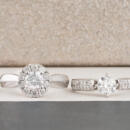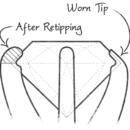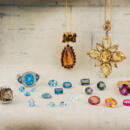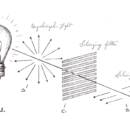Search Results
Fine Jewelry University Articles matching: “split prong”
Showing only FJU Article results. Click here to show all results.
Fine Jewelry University (Show All FJU Articles)
-

Anatomy of a Ring
…any bands or other rings you plan to wear next to the main ring? Head The head is the piece that holds the gemstone. Pronged heads are most common. The prongs are the little claws of metal that secure the stone. Most prong heads in rings …because there are more points that have to fail for the stone to come out, but they also cover up more of the stone. Prongs, like shanks, can wear away and need to be built up to prevent the stone from falling out. The very top of the …
-
Caring for and Cleaning Your Jewelry
… because it evaporates so quickly. Do not use any cleaning solutions that contain oil as they will spot and dull the stone. For hard spots you can use toothpicks and dental floss. Be careful not to scratch the metal or lift the prongs. A final wipe with a lint-free cloth will remove any dust or water spots. One final cleaning precaution, do the cleaning in a bowl on a clean table just in case the diamond becomes dislodged; you can find it easily. I have seen diamonds …
-

Jewelry Repair FAQ
… why do I need it? In a large number of jewelry pieces, the valuable diamonds and gemstones are held in place with prongs. With wear, the tops of these prongs can become worn down. If the prongs wear down too much, the stone becomes at …. Retipping is the process of adding a small amount of metal (usually gold or platinum) to the top of worn down prongs to keep the gemstone secure. In the past, almost all gemstones had to first be removed from their mountings for …
-

How Are Lab Grown Diamonds Made?
…. There are three basic manufacturing processes used to make HPHT diamonds: the belt press, the cubic press, and the split-sphere (BARS) press. The goal of each process is to create an environment of extremely high pressure and temperature…technology has been constantly advancing. Belt press designs have been dramatically scaled up, more modern cubic and split-sphere presses have been introduced which are more efficient, and larger, more perfect gems are being produced. As …
-

Gem in the Spotlight: Topaz
… for reference: Refractive index: 1.619 to 1.627 Birefringence: 0.008 to 0.010 Specific gravity: 3.53 Mohs Hardness: 8 Care and Cleaning Even though it’s tough to scratch, you should protect your topaz from hard knocks. It can be split with a single sharp blow, a trait it shares with diamond. Clean with mild dish soap; use a toothbrush to scrub behind the stone where dust can collect. Never use ultrasonic or steam cleaners on topaz. Sudden changes in temperature can …
-

The Magic of Polarized Light
… efficiently as they do without negative side effects. Using Polarized Light in Gemology Some gemstones, due to their unique chemical structure, actually polarize light themselves. These gems are doubly refractive (DR) and they will split incoming light in multiple directions. Some common examples of doubly refractive gems are sapphire, tourmaline, and moissanite. These are contrasted with singly refractive (SR) gems like diamond that only bend light in one direction. …
-
Learn Secret Diamond Buying Skills From a Professional Diamond Buyer
…. There is one more “C” if you are looking to buy a previously owned diamond. Condition is critical to value in estate diamonds. A chipped diamond loses a lot of value. You must look very carefully for chips. Chips may be under a prong. It would be a good idea after you agree on a price of a non-chipped diamond to have the diamond removed by a jeweler just to make sure. This costs a little but can save you from a poor buying experience. In a technical versus emotional …